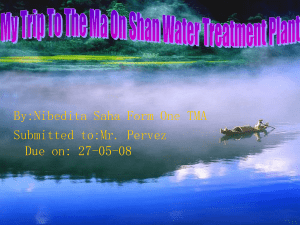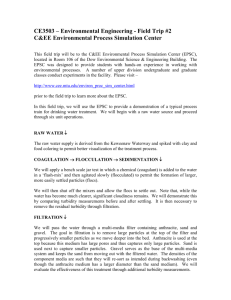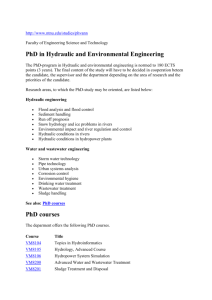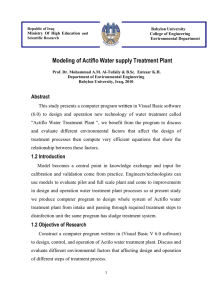Modeling of Conventional Water supply Treatment Plant
advertisement
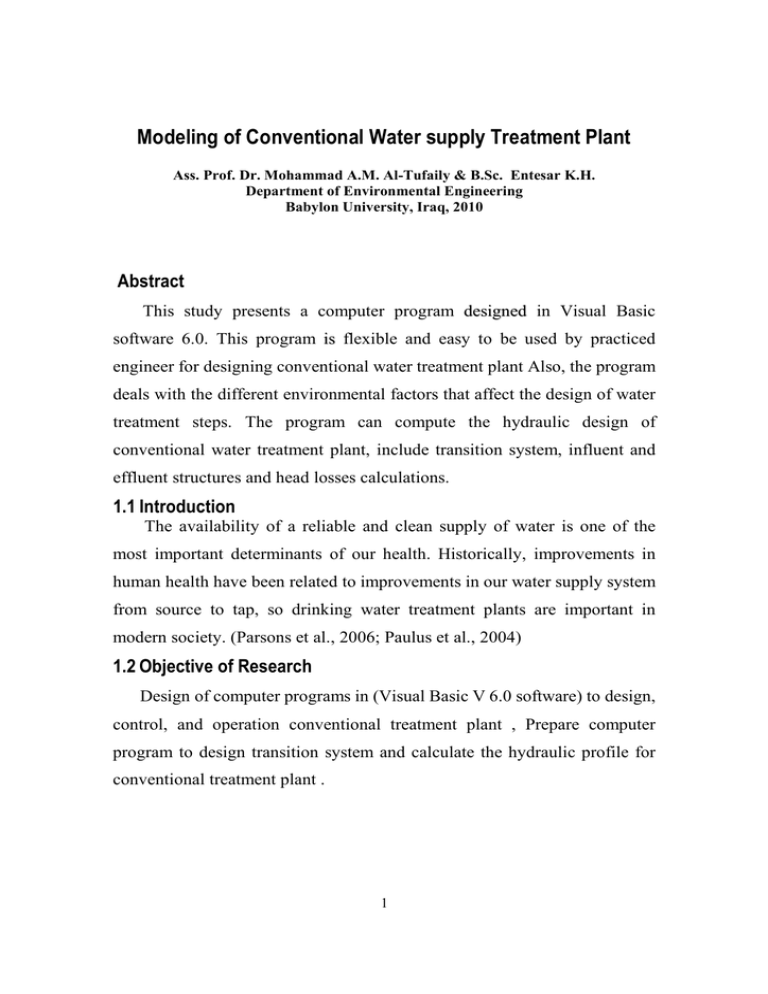
Modeling of Conventional Water supply Treatment Plant
Ass. Prof. Dr. Mohammad A.M. Al-Tufaily & B.Sc. Entesar K.H.
Department of Environmental Engineering
Babylon University, Iraq, 2010
Abstract
This study presents a computer program designed in Visual Basic
software 6.0. This program is flexible and easy to be used by practiced
engineer for designing conventional water treatment plant Also, the program
deals with the different environmental factors that affect the design of water
treatment steps. The program can compute the hydraulic design of
conventional water treatment plant, include transition system, influent and
effluent structures and head losses calculations.
1.1 Introduction
The availability of a reliable and clean supply of water is one of the
most important determinants of our health. Historically, improvements in
human health have been related to improvements in our water supply system
from source to tap, so drinking water treatment plants are important in
modern society. (Parsons et al., 2006; Paulus et al., 2004)
1.2 Objective of Research
Design of computer programs in (Visual Basic V 6.0 software) to design,
control, and operation conventional treatment plant , Prepare computer
program to design transition system and calculate the hydraulic profile for
conventional treatment plant .
1
1.3 Objectives of Water Treatment
Three basic purpose of Water Treatment Plant are as follows:
To produce water that is safe for human consumption.
To produce water that is appealing to the consumer.
To produce water
using facilities which can be constructed and
operated at a reasonable cost.
Production of biologically and chemically safe water is the primary goal
in the design of water treatment plants; anything less is unacceptable.
The second basic objective of water treatment is the production of water
that is appealing to the consumer. Ideally, appealing water is one that is clear
and colorless, pleasant to the taste, odorless, and cool. It is none staining,
neither corrosive nor scale forming, and reasonably soft.
The third basic objective of water treatment is that water treatment may be
accomplished using facilities with reasonable capital and operating costs.
Various alternatives in plant design should be evaluated for production of
cost effective quality water. .(CPCB, 2003)
1.4 Conventional Water Treatment Plant
The treatment processes of raw water before it can be used for public
consumption must be based on removal level of impurities to comply with
various guidelines. The extent of treatment depends upon the quality of the
raw water and the desired quality of treated water. (Hong, 2006)
The choice of which treatment to use from the great variety of available
processes depends on the characteristics of the water, the types of water
quality problems likely to be present, and the costs of different treatments.
The processes and technologies used to remove contaminants from water
2
and to improve, protect water quality are similar all around the world. The
most widely applied water treatment technology, a combination of some or
all ;intake, pre-sedimentation, coagulation, flocculation, sedimentation,
filtration, disinfection and sludge processing. These paths of treatment called
"Conventional water treatment plant".
1.5 Treatment Steps at Conventional Water Treatment plant
1.5.1 Intake structure
Raw water intake structure are used to control of withdrawal raw water
from a surface source, thier primary purpuse to selectively withdrew the best
quality water while excluding fish, floating debris, coarse sediment, and
other objectionable suspended matter,that acheived by supplied the intake
with screen technology (e.g fine screen and coarse screen).(Qasim et
al.2000)
The design of water supply intakes requires a series of design
considerations in order to arrive at a desirable concept that can obtain and
deliver the water economically with an acceptably low impact on the
environment. (Alsaffar and Zheng, 2007)
1.5.2 Pre-sedimentation
Pre-sedimentation is a step that is often required before coagulation and
flocculation in order to remove large particles from the raw water stream.
These larger particles can reduce the efficiency of the coagulation and
flocculation process. Settling of larger-sized particles occurs naturally when
surface water is stored for a sufficient period of time. (FSCI, 2003)
3
1.5.3 Coagulation
Latterman 1999 defined Coagulation as a complex process, involving
many reactions and mass transfer steps. As practiced in water treatment the
process is essentially three separate and sequential steps: coagulant
formation, particle destabilization, and inter-particle collisions. These
processes had been achieved by adding chemical material.
1.5.3.1 Coagulants
These chemicals involved in coagulation are known as coagulants or
coagulant aids. Coagulants are simple electrolytes that are water soluble,
with a low molecular weight in organic acid, bases or salts. Choice of
specific coagulants and coagulant aids depend on the nature of the solid–
liquid system to be separated (Fernandez 2002).
One of the more common coagulants used is aluminum sulfate, another
iron (II) is other common coagulants. The use of Fe (II) appears to be the
most promising of the ClO2 removal techniques and has been successfully
used in laboratory and, to some extent, in pilot and full-scale studies Another
coagulant is iron (III) which is lower costs and in some cases slightly better
removal of natural organic contaminants.(Hong, 2006)
1.5.3.2 Coagulant Dos
Optimum pH and coagulant dose vary significantly with raw water
characteristics. The best approach for determining the treatability of a water
source and determining the optimum parameters (most effective coagulant,
required dose rates, pH, flocculation times, most effective flocculants aids)
is by use of a jar test.
Fernandez 2002 thought that the simple jar test cannot perfectly
simulate conditions in full scale coagulation or a clarification process.
4
Menendez et al. 2007 showed that there was no rule or equation that
perfectly correlates the appropriate alum dosing with the turbidity of the
influent water, this is because it depends on the chemical properties of the
water, such as the pH, as well as the composition of the matter causing the
turbidity, but the following equation gives an approximate alum dose for a
given turbidity. The operator should note however, that this is only an
approximation and that the operator should change the dose based on plant’s
reaction, using corresponding effluent turbidity as a measure of
performance. Note that for equation the units for turbidity (T) are NTU and
for alum dose (CD) the units are mg/L.
CD = 33 * log(T) − 28
1.5.3.3 Flash Mixing
In the coagulation process, coagulant chemicals are added to the water as
it passes through the static or flash mixer. A static or flash mixer is used to
mix chemicals into the water quickly; it does this by the turbulence created
by the mixer, so agitation of water by hydraulic or mechanical controls
mixing cause velocity gradients. (CPCB, 2003)
Rapid mixing chamber consists of a mechanical mixer with an impeller
or propeller to create turbulence in this chamber, the axis of rotation for
mixer is vertical or horizontal on the direction of flow. There are two main
conditions that have effect on the rapid mixing and flocculation process.
1. The intensity of agitation is called velocity gradient.
2. Agitation time is defined as the ratio of the volume chamber to the
flow entering through this chamber.(Fernandez, 2002)
In the design of rapid mixer, the detention time is less than the detention
time in the design of the slow mixer for flocculation. Another equipment
used to disperse the chemical in coagulation process consist of a channel
5
with fully turbulent flow of sufficient length to yield the desired detention
time, followed by a hydraulic jump, has been used successfully.
1.5.4 Flocculation
FSC I 2003 defined flocculation as slow stirring process that causes the
flocs to grow and to come in contact with particles of turbidity to form larger
particles that will readily settle. The purpose is to produce a floc of the
proper size, density, and toughness for effective removal by sedimentation
and filtration. Floc formation depends on the rate at which collisions
between flocs and particles occur, and how the flocs stick together after
collision. Gentle mixing during this stage provides maximum particle
contact for floc formation, whilst minimizing turbulence and shear which
may damage the flocs. Effectiveness of flocculation depends on the delay (or
contact) time and mixing conditions prior to any flocculants being added, the
rate of treatment, water temperature and the mixing conditions within the
flocculation chamber.
Flocculation basins are normally designed with multiple mixing
compartments in a series, with a velocity gradient successively lower in each
compartment. This type of design is called (tapered flocculation)
1.5.5 Sedimentation
Qasim ,2000 define sedimentation as a physical treatment process that
utilizes gravity to separate suspended solids from water. This process is
widely used as the first stage in surface water treatment to remove turbidity
causing particles after coagulation and flocculation.
Conventional clarifiers (or sedimentation tanks) may be classified on the
basis of flow direction (horizontal, radial, or up flow), the presence or
6
absence of a sludge blanket, and shape (circular, rectangular, or
hopper/wedge bottomed).
Parsons and Jefferson 2006 at their study showed that Particles at
sedimentation unit may settle in one of four distinctively different ways
depending on concentration and the relative tendency of the particles to
agglomerate while they settle. At low solid concentrations, typically less
than 500– 1000 mgl-1, settlement occurs without interference from
neighboring particles. As the concentration increases the influence of
surrounding particles increases the settling rate. As the particle concentration
increases further the process changes from clarification to hindered settling
and thickening. As a discrete particle settles it will accelerate, under the
force of gravity, until the drag force on the particle balances its weight force.
At this point the particle descends at a constant velocity called the terminal
settling velocity. The exact expression for the terminal settling velocity
depends on the flow regime around the particle as it settles.
There are many factor affect the sedimentation basin these factors are:
• Particle Size.
• Water Temperature
•
• Detention Time
Rise Rate.
• Weir Loading Rate.
1.5.6 Filtration
Filtration is the process of passing water through a porous medium
with the expectation that the filtrate has a better quality than the influent, the
medium is usually granular bed, such as sand, anthracite, garnet, or activated
carbon (Najee, 2007).
Filters can be classified according to the medium type as:
1. Single (mono.) medium filters:
7
2. Dual media filters:
3. Mixed-media filters
There are two types of filter which are used in water treatment plant:
Slow sand filters and rapid sand filters. (Tebbutt, 1998).
Qasim 2000 stated that the mechanisms by which granular filtration
media remove solids from water are complex and are not fully understood.
Common suggest a number of mechanisms that act simultaneously in the
solids removal process, these mechanisms are:
• Straining.
• Sedimentation.
• Impaction, and
• Interception.
A filter bed must be cleaned when either (1) the head through the filter
exceeds the design value, (2) turbidity break through causes the effluent
quality to be less than a minimum acceptable level, or (3) a pre-selected
maximum filter run time has passed since it was last cleaned-Filter units are
cleaned by backwashing.
1.5.7 Disinfection
Disinfection is normally the last step in purifying drinking water. Water
is disinfected to destroy any pathogens which passed through the filters
Chlorine is the one of the most common disinfection chemical that being
used. Most of the plants surveyed used chlorine as their disinfection agent.
(Hong, 2006)
The primary purpose of disinfecting water supplies is to inactivate
microbial pathogens to prevent the spread of waterborne diseases. (Parsons
and Jefferson 2006)
8
1.6 Sludge Treatment Processes
1.6.1 Sludge thickening
After removal from a clarifier or sedimentation basin, sludge can be
thickened in a gravity concentration tank. Thickening can be economically
attractive in that it reduces the sludge volume and produces a more
concentrated sludge for further treatment in the dewatering process, or for
perhaps hauling to a land application site. Some dewatering systems will
perform more efficiently with higher solids concentrations. Thickening tanks
can also serve as equalization facilities to provide a uniform feed to the
dewatering step. Although there are a few types of thickeners available on
the market, the water industry almost exclusively uses gravitational
thickening. (Raymond and Latterman, 1999)
Sludge thickening mainly involves physical processes such as gravity
settling, flotation, centrifugation, and gravity belts.
1.6.2 Sludge dewatering
An advantage of dewatering is that it makes the sludge odorless and nonputrescible, the simplest method of drying the sludge is to apply it on open
drying beds, in a sludge-drying bed, part of the sludge water is removed by
seepage and part is evaporated by sun's heat. When the thickened sludge is
applied on the drying beds, the gases adhering to the sludge particles are
released to atmosphere. As a result, the sludge particles rise to the surface
and float. The sludge water settles down and seeps out of the bed. The
drying beds are the best and most suitable type of dewatering of sludge.
(Metcalf and Eddy, 1991).
1.7 Hydraulic Profile
9
Hydraulic profile: is the graphical representation of the hydraulic grade
line through the treatment plant. The total available head at the treatment
plant is the difference in water surface elevations in the influent of first
treatment unit and that in the effluent of last treatment unit. If the total
available head is less than the head loss through the plant, flow by gravity
cannot be achieved. In such cases pumping is needed to raise the head so
that flow by gravity can occur. Intermediate pumping in the plant is
considered poor planning and design .It is expensive option and is
unwarranted (Qasim et al., 2000).
The calculation of a water treatment plant hydraulic grade line involves
much more than the simple summation of head losses through the processes.
Coincident with determining the hydraulic profile, obviously needed to
prevent spillage over the channel and tank walls, are other important
hydraulic considerations. One important consideration is the necessity for
equal distribution of flow among the various unit processes.
(Lane and Barthuly, 2004)
1.7.1 Hydraulic Design
There are many basic principles that must be considered when
preparing the hydraulic profile through the plant. Some are listed below:
1. . The head losses through the treatment unit include the following:
a. Head losses at the influent structure.
b. Head losses at the effluent structure.
c. Head losses through the unit.
d. Miscellaneous and free fall surface allowance.
10
2. The total loss through the connecting piping, channels and
appurtenances is the sum of following:
a. Head loss due to entrance.
b. Head loss due to exit.
c. Head loss due to contraction and enlargement.
d. Head loss due to friction.
e. Head loss due to bends, fittings, gates, valves, and meters.
f. Head required over weir and other hydraulic controls.
g. Free-fall surface allowance.(Qasim et al., 2000)
2.1 The Computer Program
A computer program is written by using Visual Basic 6.0 software
which is an event-driven programming language and associated development environment prototyped by Alan Cooper as Project Ruby, then bought
and vastly improved upon by Microsoft.
2.1.1 Design and Operation of Treatment Plant
1. Inter the general information data which will be used to determine of
future population (Pf), total average flow rate (Qavg), maximum design
flow rate (Qm) .
2. Design intake unit
Design of intake, input data include maximum flow rate and
maximum velocity through gate or pipe (according to type of intake
structure ).
Design screening chamber, Input data include maximum velocity
through bar rack, bar spacing, bar width, and maximum velocity
through fine screen.
11
Design of storages units, input data include detention time, width to
length ratio, selected depth.
3. Design of coagulation treatments units input data includes detention time,
velocity gradient, length to width ratio, selected depth or width, width to
depth ratio, type of flow created by impeller, impeller type.
4. Design of flocculation treatments units
Input data includes detention time, velocity gradient, and length to
width ratio , selected depth , width to depth ratio gear efficiency and
bearing efficiency for agitation requirement. There are input data for
flocculates equipment design include paddle wheel diameter to water
depth ratio, width of blades, space between blades , and velocity of
paddle to water velocity ratio.
5. Design sedimentation treatment units
after select shape of sedimentation unit(circular or rectangular), forms
of input data for each type must be entered, includes assuming values
of surface overflow rate SOR, detention time, weir loading for
determining volume of the basins, dimensions, actual SOR.
6. Design of filtration units.
For unit sizing design by assuming values of area of unit, average
loading rate, length to width ratio.
For backwash system design by assuming backwash rate, surface
wash rate, backwash time, surface wash time, filtration cycle.
For filter media design, input data include type of filter media then the
program will choose number of layers, uniformly coefficient of media
and effective size of media.
For under drain system design, by assuming size of opening in lateral
then the program will automatically select the space for opening in
12
lateral, space between laterals, number of laterals and main header,
number of opening in lateral, total opening in unit, all required check
with standard design criteria
7. Design of Disinfection units:
Input data includes detention time, length to width ratio, selected
depth, width to depth ratio, and then the program will be work to
determine the suitable dimensions, check detention time.
8. Design of sludge process system
The program provides sludge treatment system represents by filter back
wash recovery basins, thickening units, and drying bed. Input data needs for
design these system include (detention time and over flow rate for filter
backwash recovery basin) and minimum and maximum hydraulic solid
loading, solid loading) for thickening units.
2.1.2 Design Transition System and Hydraulic Profile Calculations
This program includes the required steps for:
2.1.2.1 Structure's design
Design the influent and effluent structure of each treatment units
including transition pipes and channels of conventional water treatment
plant.
2.1.2.2 Head loss calculations
The program will be calculated head loss in each unit including (influent,
effluent and transition structures), then plus these losses to "MWE", main
water elevation to calculate the water elevation in each segment of units,
(main elevation that fixed in the beginning of design "water level at clear
well").
13
Fig.(1.1) General Information necessary for design the
Fig. (1.2): Module for design Tower Intake
Conventional Water Treatment Plan
Fig. (1.3) input data needed to design transition pipes and
wet well pump station
Fig. (1.4) input data needed to
design coagulation unit
Fig.(1.5): General Information necessary for calculate
Conventional water Treatment Plan hydraulic profile
14
Fig. (1.6): Module for calculate hydraulic
losses and hydraulic
profile through sedimentation unit
2.2 Analysis of Result
For ensure the perfect operation for the program and the relations
between the factors that affecting the design of the studied water treatment
plants, the statistical models which are describe was established.
2.3 The Regression Analysis Technique
The relationship between a single variable Y, called dependent
variable, and one or more independent variables, x1, … xk are explained or
modeled by a multiple regression analysis. The regression analysis was done
by using "Data Fit" program version 8.0.
2.3.1 The Dependent Variables (y)
In the present work, the volume of treatment units, required area and
power required assumed to be the dependent variables (y)
2.3.2 The Independent Variables
Multiple independent variable (also named as explanatory variables or
predictors) following table (1.1) shows these variables.
Table (1.1) Independent variables
Variable
Description
x1
Population factor, capita
x2
Design period, y
x3
Growth rate
x4
Consumption, l/c.d
x5
Time of storage, min.
x6
Coagulation time, sec.
x7
Flocculation time, min.
x8
Surface loading rate m3/m2.d
x9
Filtration rate, m/h.
15
2.4 Regression Models for Designing water Treatment Plants
Multiple non-linear regression models in three forms were used for each one
of design requirements to choose which form gives the best fitting of data,
from these models we selected three models that give the best fitting of data.
Table (1.2): The Proposed Models
No.
Equation Description
A
y = b1 x 1 + b 2 x 2 + ... + b k x k + G
B
y = exp(b1 x 1 + b 2 x 2 + ... + b k x k + G)
C
y = b1x1 + b 2 x 2 + ... + b k x k
Where;
y = dependent variables.
x1, x2, …, xk = the independent variables.
b1, b2, b3, …bk = are model coefficients, and
G = model constant term.
2.5 Result of Study: The result presented in table (1.3).
Table (1.3) result of study
Y
Models
R2
Stand.
Err
Opening area of intake
y = 0.000083x 1 + 0.11x 2 + 0.707x 3 + 0.108x 4 − 34.874
0.999
0.02
Volume of storage unit
y = 0.001x 1 - 1.586x 2 + 11.382x 3 + 1.553x 4 + 139.052x5 - 928.37
0.999
3.134
Volume of coagulation unit
y = 0.000 x 1 - 0.442x 2 + 2.014 + 0.397 x + 1.973x − 181.518
1
3
4
6
0.902
13.395
Power of coagulation unit
y 2 = 0.000 x1 + 0.235 x2 + 1.349 x3 + 0.215 x4 + 1.293x6 − 127.29
0.999
0.243
Volume of flocculation unit
y = 0.012x1 - 16.18x2 + 101.724x3 + 15.685x 4 + 141.153x7 − 9257.917
0.999
2.547
0.983
1223.2
4
0.987
29.495
Volume of sedimentation unit
Area of filtration
0.00000225 * x1 + 0.0034 * x 2 + 0.027 * x3 + 0.003 * x 4
− 0.035 * x8 + 9.602
0.0000023 * x1 + 0.003 * x 2 + 0.023 * x3 + 0.003 * x 4
y = exp
− 0.095 * x9 + 5.866
y = exp
16
2.6 Verification of Computer Program Results
To make sure that the program works successfully, verification must be
done. That achieved either comparison hand calculation results for specific
design values with program result for same design values ( that processes
repeated many times then verification will be estimated), or comprised
program result for specific condition with actual water treatment plant exists
around us worked with same conditions.
3.1 Conclusions
From the present study the following conclusions can be obtained:
1. A computer program for the design of conventional water treatment
plants was developed, user can design the different water treatment
processes as well as maintain the plant operation. This application is
simple through inter input data needed for each process that provided ,
the program provide feature that enable the user to change the input
data needed for each unit from lists contained different type of these
parameters .
2. The program had been designed to provide separate operation for
treatment processes that we can pass one of the treatments which
consider not required, dependent on the raw water quality and treated
water quality required.
3. For present study computer program for design transition system
between conventional water treatment plant units and calculate the
head losses through the plant then compute the hydraulic profile for
plant had been developed, then we can compute total available head
provided for plant, that consider the controlled point in estimate the
17
type of flow that achieved in plant (gravity flow or needed for
pumps).
4. The design was developed considering the effect of the environmental
factors, by use data statistics program called (data fit), we can
successfully
produce
an
equations
connect
between
these
environmental factors and plant variables. The verification for the
program had been adopted, shows a very good agreement.
References
Alsaffar A. M., and Zheng Y. , (2007), "Water Intakes - Siting and
Design Approaches" Bechtel Corporation 9801 Washingtonian
Blvd.Gaithersburg, Md 20878, , Maryland, USA.
Central Pollution Control Board, (CPCB), (2003), "Status of Water
Treatment Plants In India" Ministry of Environment and Forests,
India, Website: www.Cpcb.Nic.In, E-Mail: Cpcb@Nic.In.
Fernández, e. and Gálvis, a., (2002), "Artificial Neural Networks
Model Used for Clear Water Treatment Plants" Instituto Cinara,
Universidad del Valle. Dirección Postal, 25157, Cali, Colombia.
FSC Architects and Engineers, (2003) "Class I Water Treatment
Plant Operator Program Manual "Government of the Northwest
Territories Municipal and Community Affairs, 53 4910 rd Street
P.O. Box 1777 Yellowknife, NT X1A 2P4.
Hong, C. K., 2006, "Development Of A Decision Support System
For Drinking Water Treatment Process Design (Water-Dss)" MSc.
thesis, College of Engineering, Department of Environmental
Management, University Technology, Malaysia.
18
Lane, Th. J., and Barthuly, P. D., (2004), "Water Treatment Plant
Design" McGraw-Hills, New York.
Menéndez, D.et al. (2007), " Ojojona Plant Manual"
Metcalf and Eddy, Inc., 1991 "Wastewater Engineering Treatment,
Disposal, and Reuse", McGraw- Hill, New York.
Najee, A. S., (2007), "Computer Program of Package Water
Treatment Plants Design" MSc. thesis, College of Engineering,
Department of Civil Engineering, Babylon University, Iraq.
Parsons, S. A. and Jefferson, B., (2006), "Introduction to Potable
Water Treatment Processes" School of Water Sciences Cranfield
University, by Blackwell Publishing Ltd UK.
Paulus
J.
G.,
(2004),
"Diagnosing
the
Hydrodynamic
Characteristics of A drinking Water Treatment Plant" School of
Engineering Faculty of Engineering, Physical Sciences and
Architecture, The University Of Queensland.
Qasim, S. R., Motley, E.M. and Zhu, G., (2000), "Water Works
Engineering", Chiang, Patel and Yerby, Inc., Dallas, Texas.
Raymond D., Letterman, R. D., (1999), "Water Quality and
Treatment" A handbook of community water supplies. American
Water Works Association, McGraw-Hill. New York.
Tebbutt, T. H. Y.; (1998), "Principles of water quality control",
Butterworkh Heinemann.
19
ﺍﻝﺨﻼﺼﺔ
.6.0إن ا(% #!$%4ن و 01
ِ'-ُ/م ه*) ا('را ِ َِ !" #!$%ال ِ
ا@ '?6ام > 04:ا('81س ا(%6س وآ*( د 9:ا(.)! (!E( AB'-/ ACD 6( #7!68
0ا( َ G4ا(? َ P6ا(%NOة CK / HLات )! (!E
0ا(Eا َ
آ*( '1Bف ا( #!$%4إ(ُ D/ H
ا(%Rب.
WC6Bا( #!$%4ا !686ج ا( 6ا('1رو( ACD( Uا(!S$ !8T6 AB'-6م ا( 0-8و!R8ت ا('ا0K
وا(?!رج ("'ات و"!!ت %7!Kا(!B%ن.
/إ!4Nت د #7!6$ :ا(!- #!$%4ر!CD( #7!6$ W !16$ت A AEا Cا(%Cق ا(AB'-6
و 0Y!P/ه*) ا(!CDت /ا(Dل > !1Lا(!-6ر %Bأ(R8ر) أو آ Z6و!در .)'6E
ت ا\"!'L > 7د > ا(%6ات ا( ِ-6وا(%6ات ا('6Eة /ا '?6ام
\!Bد ا(ِ !:]ِE
_ -B%ا( 0D6ا@'D$ار ا(] ّCKا(ّ'E6د ! !E6ل #!$%ا\"! ."Data Fit 8.0" 7و0R/
ا(%6ات ا( -6آ'L) > 0د ا(!Uن ا( -C8ا(?'وَ ،ا( %Eا( ،6ا@ ]16ك ا(
( d?Rا(ا"' $ 4$ ،ا(!Uن أ( A-C8ا(?'و،ز> ا(!-4ء آ 0و"'ة 'E، A(!Eل
ا( 0Dا( DCو'Eل ا( !8 (gh%6ا(%6ات ا('6Eة ا(ُ 6أَ*ِKت >Eا@!46Lر ه )"
ت ا( ،ِ(!Eا( A:!Cا@ز gj/ /.(0R6( Aا( > A:]Eا(%6ات ا( A-6وا()'6E
و"'ا ِ
!Eد@ت آPءة.
ا( #!$%4ا( 'Eه*) ا('را 01ا@ '?6ام ،و%ن > " mا!6Kر ا$lاع ا(?> P6
ا(!(!Eت دا 0Kا( ، CDوإ!دة ا( > '81وا(! >n"!4ل ا( '81ا( ) G4ا( '81ا((D
!( #7!68ا('E6دة (]ر!-/ء وا('-6م !ل ا( mD4ا( 'K 04 Eا\!$ن وا(.G4
20
16
Calibration equation
Plant result=1 [program]0.999
R2=0.999
References line
12
9
Calibration equation
Plant result=1.01 [program] 0.997
R2=0.999
References line
14
actu al p lan t resu lt
actu al p lan t resu lt
15
6
3
12
10
8
6
4
2
0
0
0
3
6
9
12
15
0
program result
Fig. (1.7): verification of intake unit for
conventional treatment plant model
18
12
10
actual plant result
actual plant result
14
8
6
4
2
1000
950
900
850
800
750
700
650
600
550
500
450
400
350
300
250
200
150
100
50
0
0
2
4
6
8
10
12
program result
14
16
actual plant result
106.5
105.5
104.5
Calibration equation
Calibration
1
Plantequation
result=0.972 [program]
0.971
Plant result=1.14[program]
2
R =0.999
R2=0.995
References line
References line
103.5
102.5
101.5
100.5
99.5
99.5
12
14
16
Calibration equation
Plant result=1.009 [program]0.992
R2=0.995
References line
Fig (1.10): verification of sedimentation unit
for conventional treatment plant model
actual plant result
107.5
6
8
10
program result
50 10 15 20 25 30 35 40 45 50 55 60 65 70 75 80 85 90 95 10
0 0 0 0 0 0 0 0 0 0 0 0 0 0 0 0 0 0 00
program result
18
Fig. (1.9): verification of flocculation unit for
conventional treatment plant model
108.5
4
Fig (1.8): verification of coagulation unit
for conventional treatment plant model
Calibration equation
Plant result=1.05 [program]0.987
R2=0.999
References line
16
2
380
360
340
320
300
280
260
240
220
200
180
160
140
120
100
80
60
40
20
0
Calibration equation
Plant result=0.972 [program]1
R2=0.999
References line
0 20 40 60 80 10 12 14 16 18 20 22 24 26 28 30 32 34 36 38
0 0 0 0 0 0 0 0 0 0 0 0 0 0 0
100.5 101.5 102.5 103.5 104.5 105.5 106.5 107.5 108.5
program result
Fig. (1.11): verification of hydraulic profile for
conventional treatment plant model
program result
Fig (1.12): verification of filtration unit
for conventional treatment plant model
Verification Result for Present Research
21
CTP
General design information
Po, co, tf , rg,
Calculate
Pf , Qavg , Qm,
Design tower intake and
screen chamber
Design storage tank
Design coagulation units
Design flocculation units
Design sedimentation units
Design
rectangular tank
Design circular
tank
Design filtration system
Design disinfection units
Fig.(1.13): Flowchart for Computer Program
22
